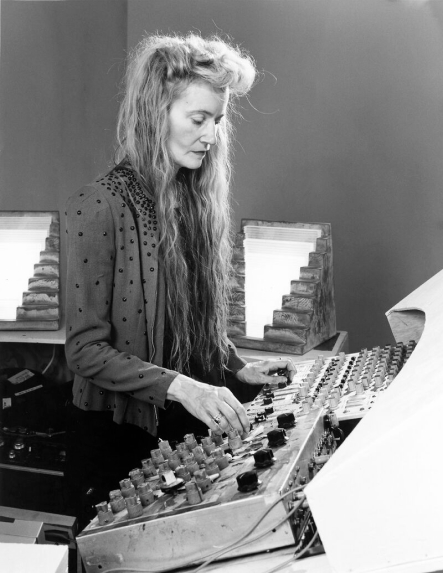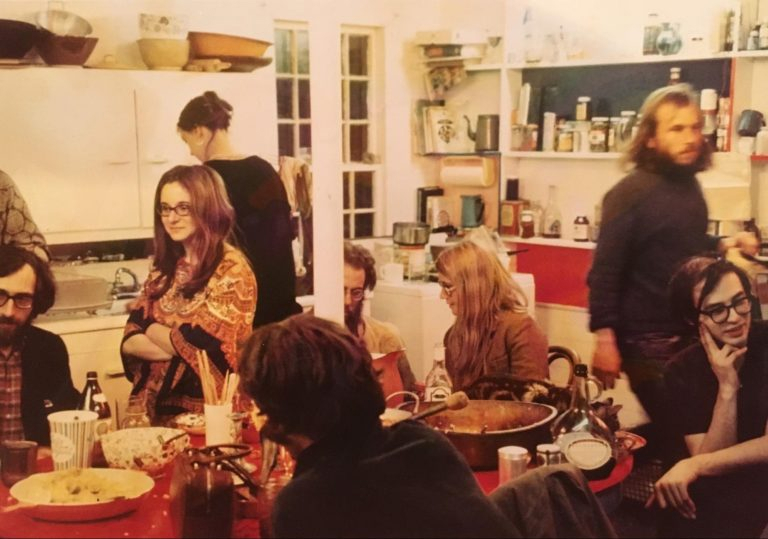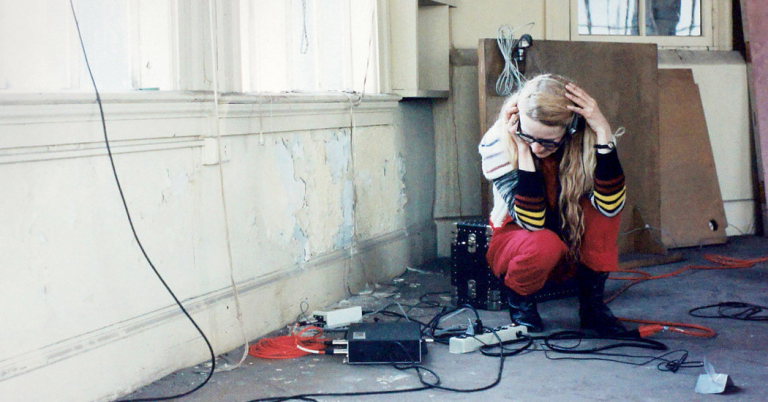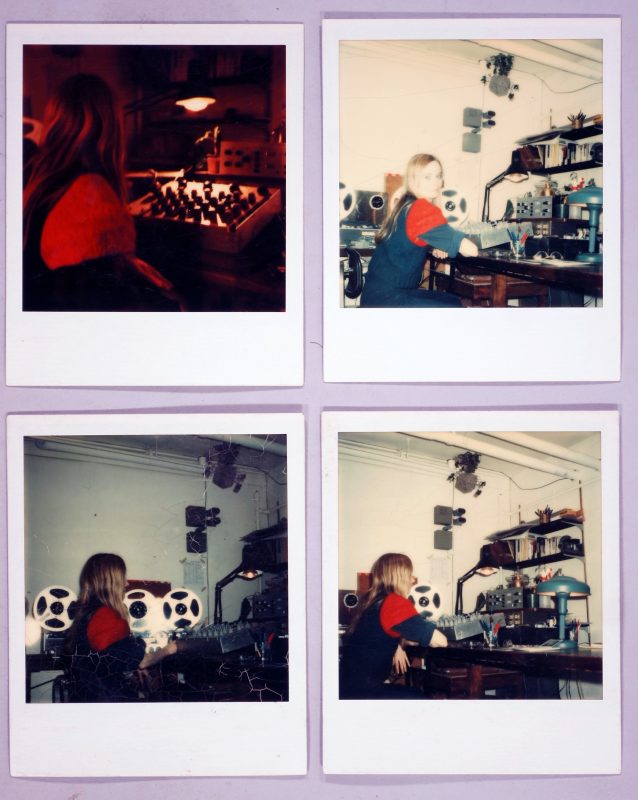
Maryanne Amacher (1938–2009) was a composer of large-scale fixed-duration sound installations and a highly original thinker in the areas of perception, sound spatialization, creative intelligence, and aural architecture. She is frequently cited as a pioneer of what has come to be called sound art, although her thought and creative practice consistently challenges key assumptions about the capacities and limitations of this nascent genre. Often considered to be part of a post-Cagean lineage, her work anticipates some of the most important developments in network culture, media arts, acoustic ecology, and sound studies.
The Maryanne Amacher Foundation was established in 2020 by a group of Amacher’s key friends, peers, and collaborators brought together by Blank Forms in order to promote and preserve Amacher’s work and legacy. Through the creation of exploratory seminars, research opportunities, public programs, and publications, the mission of The Maryanne Amacher Foundation is to broaden the greater public’s understanding of Amacher and her work.
For information and permissions regarding material in the collection please contact: maryanne.amacher.foundation@blankforms.org
Her Life

Maryanne Amacher was born in 1938 in Kane, Pennsylvania, a small town in the northwestern part of the state, just south of Erie. Amacher’s formative years were spent in Philadelphia, where she enrolled in the University of Pennsylvania in 1955. As a music major, she studied with composer and theorist Constant Vauclain, George Rochberg, and the prominent German avant-garde composer Karlheinz Stockhausen during his tenure in Philadelphia in 1964 and 1965.
After her work at UPenn, Amacher went on to hold a series of fellowships at the University of Illinois’ Studio for Experimental Music, MIT’s Center for Advanced Visual Studies, SUNY Buffalo, Capp Street Gallery in San Francisco, and many others, including the DAAD Artists-in-Berlin program. In the late 1960s, while at SUNY Buffalo, Amacher pioneered what she called “long distance music,” or telematic, site-related works that would later crystallize into her renowned City Links series. During her time as a fellow at MIT’s Center for Advanced Visual Studies (1972-1976) she began developing her “ear tone” music with the help of Marvin Minsky’s Triadex Muse, a synthesizer and compositional tool utilizing principles of artificial intelligence. Amacher’s “ear tone” music emerged from creative use of combination and difference tones, along with otoacoustic emissions (known, in shorthand, as OAEs), or sounds produced spontaneously within the cochlea. Amacher followed developments and debates in otological research on OAEs and other psychoacoustic phenomena closely. Such independent scholarship was an important stimulus to her career-long research into “ways of hearing” and the creative potentialities of how the ear itself processes sounds both of itself and in situ.
While at MIT, her extensive listening research was also profoundly influenced by a continuous, four year long, live feed from Boston Harbor to her studio via a dedicated phone line. This monophonic (transmitting no spatial information via stereo cues) environmental transmission from the Boston Fish Exchange building helped crystallize another unique focus of her approach to spatialization: that the spectral and dynamic transformation of a sound creates a subtle, but perceptible three-dimensional shape, literally, in space.
After meeting John Cage through Lejaren Hiller at the University of Illinois in 1968, she went on to collaborate with Cage in the mid-1970s on Lecture on the Weather, and composed Close Up, an accompaniment to Cage’s Empty Words (1979). Remainder was commissioned for the Merce Cunningham Dance Company piece Torse, and later the Charles Atlas film of the same name. In the late 1970s and early 1980s she developed presentational models for how her subsequent work should be “staged”: Music for Sound-Joined Rooms and Mini Sound Series.
She spent the 1980s also working on the materials for a multi-part drama originally imagined for TV and Radio simulcast called Intelligent Life. While never fully realized, Intelligent Life reveals much of her thinking on music and the advancement of potentialities for future listeners, transcending the social and physiological limitations of music as we know it.
She worked mostly in international venues throughout the 1990s—primarily in Europe and Japan. In the US she was commissioned to compose a large-scale work for the Kronos Quartet and she received a Guggenheim Fellowship, performed at Woodstock ’94, participated in the Whitney Biennale, and released her first CD on Tzadik.
In the 2000s, she joined the faculty of Bard College’s Milton Avery Graduate School of the Arts. In 2005 she received Ars Electronica’s highest honor, the “Golden Nica.” Her last commission, remaining unfinished, was an evening-length work that combined stereoscopic video and a multi-story audio composition involving roughly forty loudspeakers. She died in Kingston, NY after sustaining a head injury and a subsequent stroke during the summer of 2009.
Her Work

By her own account, Amacher’s work is best represented by three multimedia installation series produced in the United States, Europe, and Japan between the late 1960s and her death in 2009. In these major works—City Links (1967-1980), Music for Sound Joined Room, and the Mini Sound Series—Amacher refashioned composition as a dramatically staged creative undertaking in experimental acoustics. She was fascinated with the physicality of sound, the way it propagated in space, and the unexpected ways that it provoked images and sensations in the “mind’s ear.” Her approach was slow, deliberate, and empirical. She would spend hours listening to a seemingly unchanging tone or making minute adjustments to loudspeaker placement. For Amacher, these things were not details or minutiae: they were the very heart of her work, the equivalent to the painstaking working out of themes or harmonic progressions in traditional music.
In City Links, Amacher transmitted live sonic feeds from multiple cities (or multiple sites in the same city) via high-quality telephone lines and mixed these sources live during exhibitions, concert presentations, or radio broadcasts. In City (1967), a 28 hour live mix, connected eight locations around Buffalo via phone lines to WBFO. The program was recognized by the Institute for Education by Radio and Television for its innovative, experimental approach to radio’s role in fostering social community. In City Links, Amacher reflected upon the changing sense of place created by the general public’s access to air travel and telecommunications. Work titles often reflected these themes (e.g. No More Miles and Tone of Place). It was a prescient tremor of the “network culture” thematics to come in recent media art. Through 1979, she realized 21 iterations of her City Links series, many of which were collaborations with visual artists and/or architects. They took the form of installations, performances, and combinations of both.
The second work group is a site-specific series called Music for Sound-Joined Rooms. In these works, Amacher used idiosyncratic speaker placements (facing walls or the floor of her installation space) to send sound through the solid medium of built space before allowing it to circulate in air, creating multiple, overlapping acoustics. Opposed to the usual air-borne transmission of sound waves (the single carrier medium for all traditional Western music), she referred to this practice in her writing as structure-borne transmission. In such works, the architectural site of the installation itself became the physical medium of the work, shaping and coloring the sounds as they propagated through it. The first piece in this series was Living Sound: Patent Pending (1980), presented as part of the Walker Art Center’s New Music America programming. Amacher described it as follows:
The house, on a hill in St. Paul with its panoramic view of Minneapolis, was lit by tall quartz spots, as if a movie set. The time: midnight. [In the] music room, where two grand pianos had been, was now an “emergent music laboratory,” there were 21 petri dishes with something growing in them — the musicians and instruments of the future. DNA photos and biochemical diagrams were placed on music stands. Meanwhile, the entire house was full of a spectacular sound — incredible loud and unbelievably dense — sound, circulating throughout the rooms, out the doors and windows, down the hill, past sedate Victorian mansions. It seems to contain the energy of all frequency ranges at once, yet never approached white noise. [Listeners] felt themselves pushed, as if by acoustic pressure, out into the garden, where the entire house was heard, sounding, as a gigantic instrument.
Finally, Amacher’s Mini Sound Series is comprised of a group of multimedia installations based on the television miniseries format. In the Mini Sound Series, an ensemble of “sound characters” distinguished by unique timbral, gestural, and contour profiles interact and develop in relation to each other over several days or weeks, following dramatic narrative techniques drawn from television and other popular forms. Mini Sound Series was an important departure from the conventions of endless-duration sound installation practices, which Amacher found to be asking overly diffuse attention of the listener. Instead, Amacher explains, the Mini Sound Series allows, “people to return and identify certain characters, having gotten to know them in [previous] features.” Uniting all of these works is a holistic concern with the entire network of processes that comprise the experience of music—in her own words, such a set of processes emphasizes that, in Amacher’s words, “how certain sounds are to be perceived in a sonic world becomes as important as the sounds themselves.”
As the spatial “staging” in both Music for Sound Joined Rooms and Mini Sound Series became increasingly critical to the work series’ articulation, Amacher began developing visual components that function to both heighten the overall aesthetic experience of a visitor and to also guide them through the series of rooms that would frame a given work. These visual components were comprised largely of original videos and slide projections, but also include scrolls, 3D-images, objects, and texts.
The Archive

In partnership with the Foundation, The New York Public Library for the Performing Arts has acquired Maryanne Amacher’s archive, which is now available for public research. Browse the finding aid online, or request an in-person research appointment.
As a whole, Amacher’s work and collected archive represents one of the most important artistic contributions of recent decades. Assembled shortly before her death in the summer and fall of 2009, The Maryanne Amacher Archive contains a wealth of knowledge and research potential that promises to be a source of interest and inspiration for generations of artists and scholars to come. Much of the material was organized by Amacher herself, including for example, a critical series of folders and small boxes containing what she felt to be the most important works and writings from various periods. She also kept her annotated drafts, project notes, performance materials, ephemera, audio versions dating to the early ’60s, etc. With future archival efforts, research, and scholarship it will be possible to trace her working processes and ways of thinking across nearly every category of media.
In addition to notebooks, scores, sketches, and other papers, the archive consists of over 1,000 reel-to-reel tapes, hundreds of cassettes, DATs, floppy disks, videos, and audio in other various formats. The collection also includes oversize papers such as original concert posters and drawings, a miscellany of personal artifacts, and a collection of electronic music tools, some rare and custom-made, which the Foundation will house and repair.
The types of materials present in the archive vary greatly and go far beyond those of the traditional composer, typically limited to scores, recordings, sketches, and correspondence. Working with Amacher’s archive represents a unique opportunity to explore new models for archiving the composers of the future and may serve as a prototype for other composers and artists of her generation. Because Amacher’s work was grounded in first-person research focused on perceptual processes as well as site-specific techniques of sound recording, amplification, and transmission, processing her archive raises important questions about future presentations of her work—how (and if) adequate perceptual and site-specific methodologies can be (re)constructed through archival research How Amacher’s archive is treated can serve as a beacon for a new wave of archival development that must ensure that a wide range of late-20th and 21st century cultural production can be adequately communicated into the future. Standard methodologies developed around painters or orchestral composers, for example, will never capture the more ephemeral practices now pervasive in our post-disciplinary framework.
Interest in the Amacher Archive coincides with the recent emergence of sound and listening as a key concern in a wide number of scholarly, artistic, and popular discourses. The interdisciplinary field of sound studies has begun to explore how sonic phenomena like vibration, resonance, rhythm, and silence might offer new interpretive frameworks for literature, film, and social life more generally. The brain sciences have also turned to listening and psychoacoustics and Amacher’s practice is the most direct artistic investigation and utilization of inner ear distortions, what she called “Ear Tones”. Her work has been and will continue to be the subject of research in these areas. Concurrently, journalistic and critical pieces about noise regulation, music, torture, as well as sound in advertising and branding circulate with astonishing urgency in social media, blogs, and other formats. Why this so-called “sonic turn” has occurred with such force and urgency at the current moment remains a rich, compelling, and very open question–one that further engagement with the Amacher Archive will surely illuminate.